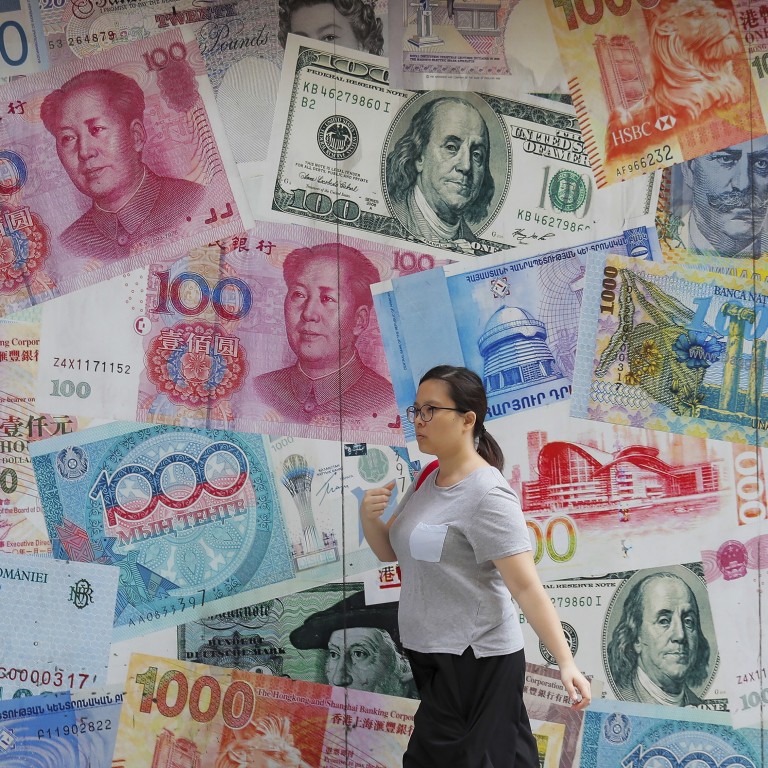
China omits US dollar from forex trading fee waivers in bid to bolster yuan
- China’s exchange regulator says waiving of transaction fees supports the national belt and road strategy, but Chinese banks still mainly use the US dollar in cross-border deals
- The euro, British pound, Japanese yen, Hong Kong dollar and Australian dollar are also not exempt from trading fees
China is waiving transaction fees between the yuan and 12 currencies, including the Singapore dollar, Russia rouble and Korean won, for three years in its onshore foreign exchange market in a clear move to skirt the US dollar.
China’s exchange regulator, the State Administration of Foreign Exchange (SAFE), said in a notice on Monday that it was waiving fees associated with bidding and asking prices in interbank trading of the yuan and the dozen currencies from August 1.
The other nine currencies are the Malaysian ringgit, New Zealand dollar, South African rand, Saudi riyal, United Arab Emirates dirham, Polish zloty, Hungarian forint, Turkish lira and the Thai baht.
The SAFE said the reason for waiving those trading fees was to “actively cooperate with the national belt and road development strategy, implement financial support for the development of the real economy, reduce corporate exchange costs, and promote the development of the direct exchange market for yuan and foreign exchange between banks”.
In addition to the US dollar, the euro, British pound, Japanese yen, Hong Kong dollar and Australian dollar are not covered by the fee exemption.
Ken Cheung, Mizuho Bank’s chief Asian forex strategist, said the waiving of trading fees is meant to encourage more direct exchanges with other currencies by skipping US dollar transactions, which in turn will promote the yuan’s usage in settlements.
“By developing this practice, market participants will be less inclined to keep as much in US dollars for other currency transactions,” Cheung said.
China officially provides direct trading service between the yuan and 20 foreign currencies in its onshore foreign exchange market. But the US dollar dominates the market, with 11.2 trillion yuan (US$1.6 trillion) worth of trade volume in the first quarter of this year, or more than 30 times the trade volume of the euro – the second-most-traded currency in the same period – according to the latest figures released by the People’s Bank of China.
Among the 12 currencies that will be covered by waived transactions fees, the Singapore dollar is the most traded, with 22.8 billion yuan (US$3.27 billion) worth of trade volume in the first quarter, while the volume for the Hungarian forint was just 20 million yuan (US$2.86 million) for the three-month period, the central bank data showed.
“I think [waiving the transaction costs] will improve and encourage the use of the yuan,” said Zhou Hao, a senior economist for emerging markets with Commerzbank. “For example, it could double from 1 per cent to 2 per cent [of overall transaction volume], but the overall market share will still be very small.”
The dominant role of the US dollar in China’s onshore interbank market reflects the fact that Chinese banks are still mainly using the dollar as the default choice to settle cross-border trade, investment and financing.
Zhang Yanling, former deputy governor of Bank of China, said China needed to be fully prepared for a total cut-off from the US dollar settlement system.
The most fundamental condition for accelerating yuan internationalisation is an increase in transaction volume
“The opinion of cutting off the channel for China or Hong Kong to enter the US dollar settlement market has been heard,” Zhang added. “It is for this reason that we need to make full preparations to protect the property of the state and people – especially the currency and securities in financial assets.”
Zhang made a number of suggestions to promote the use of the yuan and to cut China’s reliance on the US dollar, such as by boosting transaction volume in the trading of the yuan and other currencies and by launching a special national fund that would allow foreign countries to exchange the yuan from the fund to import Chinese goods.
“The most fundamental condition for accelerating yuan internationalisation is an increase in transaction volume,” Zhang said. “Investment and trade between the [European Union] and Japan are basically settled in local currencies. Southeast Asian countries are also encouraging the use of local currency for cross-border trade settlement. We should also promote this.”

